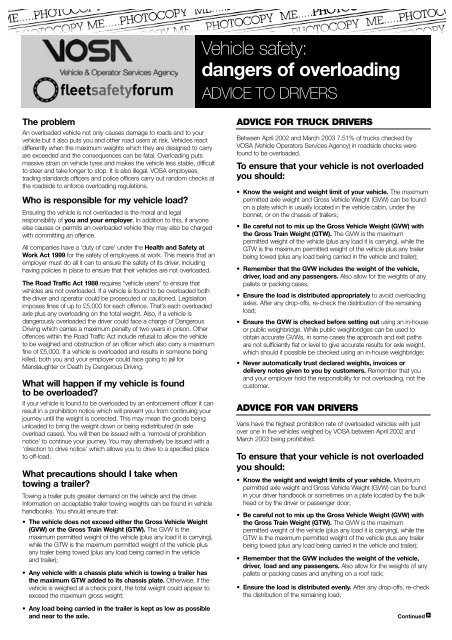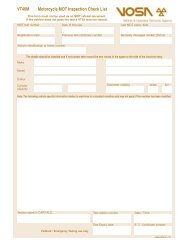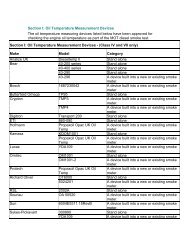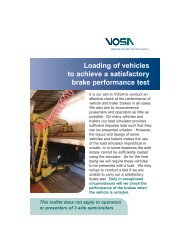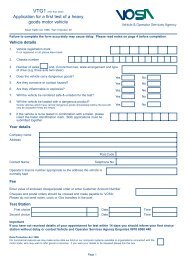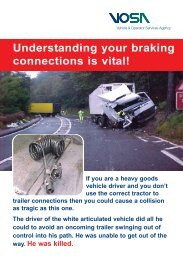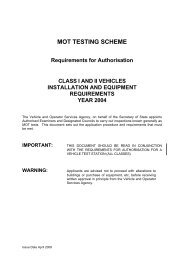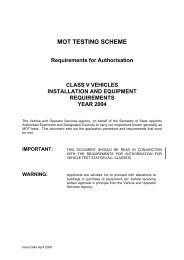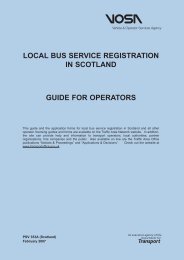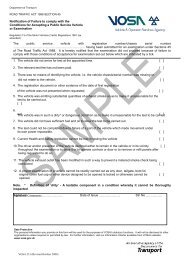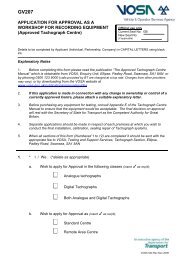dangers of overloading - Driving, transport and travel
dangers of overloading - Driving, transport and travel
dangers of overloading - Driving, transport and travel
Create successful ePaper yourself
Turn your PDF publications into a flip-book with our unique Google optimized e-Paper software.
fleetsafetyforumVehicle safety:<strong>dangers</strong> <strong>of</strong> <strong>overloading</strong>ADVICE TO DRIVERSThe problemAn overloaded vehicle not only causes damage to roads <strong>and</strong> to yourvehicle but it also puts you <strong>and</strong> other road users at risk. Vehicles reactdifferently when the maximum weights which they are designed to carryare exceeded <strong>and</strong> the consequences can be fatal. Overloading putsmassive strain on vehicle tyres <strong>and</strong> makes the vehicle less stable, difficultto steer <strong>and</strong> take longer to stop. It is also illegal. VOSA employees,trading st<strong>and</strong>ards <strong>of</strong>ficers <strong>and</strong> police <strong>of</strong>ficers carry out r<strong>and</strong>om checks atthe roadside to enforce <strong>overloading</strong> regulations.Who is responsible for my vehicle load?Ensuring the vehicle is not overloaded is the moral <strong>and</strong> legalresponsibility <strong>of</strong> you <strong>and</strong> your employer. In addition to this, if anyoneelse causes or permits an overloaded vehicle they may also be chargedwith committing an <strong>of</strong>fence.All companies have a ‘duty <strong>of</strong> care’ under the Health <strong>and</strong> Safety atWork Act 1999 for the safety <strong>of</strong> employees at work. This means that anemployer must do all it can to ensure the safety <strong>of</strong> its driver, includinghaving policies in place to ensure that their vehicles are not overloaded.The Road Traffic Act 1988 requires “vehicle users” to ensure thatvehicles are not overloaded. If a vehicle is found to be overloaded boththe driver <strong>and</strong> operator could be prosecuted or cautioned. Legislationimposes fines <strong>of</strong> up to £5,000 for each <strong>of</strong>fence. That’s each overloadedaxle plus any <strong>overloading</strong> on the total weight. Also, if a vehicle isdangerously overloaded the driver could face a charge <strong>of</strong> Dangerous<strong>Driving</strong> which carries a maximum penalty <strong>of</strong> two years in prison. Other<strong>of</strong>fences within the Road Traffic Act include refusal to allow the vehicleto be weighed <strong>and</strong> obstruction <strong>of</strong> an <strong>of</strong>ficer which also carry a maximumfine <strong>of</strong> £5,000. If a vehicle is overloaded <strong>and</strong> results in someone beingkilled, both you <strong>and</strong> your employer could face going to jail forManslaughter or Death by Dangerous <strong>Driving</strong>.What will happen if my vehicle is foundto be overloaded?If your vehicle is found to be overloaded by an enforcement <strong>of</strong>ficer it canresult in a prohibition notice which will prevent you from continuing yourjourney until the weight is corrected. This may mean the goods beingunloaded to bring the weight down or being redistributed (in axleoverload cases). You will then be issued with a ‘removal <strong>of</strong> prohibitionnotice’ to continue your journey. You may alternatively be issued with a‘direction to drive notice’ which allows you to drive to a specified placeto <strong>of</strong>f-load.What precautions should I take whentowing a trailer?Towing a trailer puts greater dem<strong>and</strong> on the vehicle <strong>and</strong> the driver.Information on acceptable trailer towing weights can be found in vehicleh<strong>and</strong>books. You should ensure that:• The vehicle does not exceed either the Gross Vehicle Weight(GVW) or the Gross Train Weight (GTW). The GVW is themaximum permitted weight <strong>of</strong> the vehicle (plus any load it is carrying),while the GTW is the maximum permitted weight <strong>of</strong> the vehicle plusany trailer being towed (plus any load being carried in the vehicle<strong>and</strong> trailer);• Any vehicle with a chassis plate which is towing a trailer hasthe maximum GTW added to its chassis plate. Otherwise, if thevehicle is weighed at a check point, the total weight could appear toexceed the maximum gross weight;ADVICE FOR TRUCK DRIVERSBetween April 2002 <strong>and</strong> March 2003 7.51% <strong>of</strong> trucks checked byVOSA (Vehicle Operators Services Agency) in roadside checks werefound to be overloaded.To ensure that your vehicle is not overloadedyou should:• Know the weight <strong>and</strong> weight limit <strong>of</strong> your vehicle. The maximumpermitted axle weight <strong>and</strong> Gross Vehicle Weight (GVW) can be foundon a plate which is usually located in the vehicle cabin, under thebonnet, or on the chassis <strong>of</strong> trailers;• Be careful not to mix up the Gross Vehicle Weight (GVW) withthe Gross Train Weight (GTW). The GVW is the maximumpermitted weight <strong>of</strong> the vehicle (plus any load it is carrying), while theGTW is the maximum permitted weight <strong>of</strong> the vehicle plus any trailerbeing towed (plus any load being carried in the vehicle <strong>and</strong> trailer);• Remember that the GVW includes the weight <strong>of</strong> the vehicle,driver, load <strong>and</strong> any passengers. Also allow for the weights <strong>of</strong> anypallets or packing cases;• Ensure the load is distributed appropriately to avoid <strong>overloading</strong>axles. After any drop-<strong>of</strong>fs, re-check the distribution <strong>of</strong> the remainingload;• Ensure the GVW is checked before setting out using an in-houseor public weighbridge. While public weighbridges can be used toobtain accurate GVWs, in some cases the approach <strong>and</strong> exit pathsare not sufficiently flat or level to give accurate results for axle weight,which should if possible be checked using an in-house weighbridge;• Never automatically trust declared weights, invoices ordelivery notes given to you by customers. Remember that you<strong>and</strong> your employer hold the responsibility for not <strong>overloading</strong>, not thecustomer.ADVICE FOR VAN DRIVERSVans have the highest prohibition rate <strong>of</strong> overloaded vehicles with justover one in five vehicles weighed by VOSA between April 2002 <strong>and</strong>March 2003 being prohibited.To ensure that your vehicle is not overloadedyou should:• Know the weight <strong>and</strong> weight limits <strong>of</strong> your vehicle. Maximumpermitted axle weight <strong>and</strong> Gross Vehicle Weight (GVW) can be foundin your driver h<strong>and</strong>book or sometimes on a plate located by the bulkhead or by the driver or passenger door;• Be careful not to mix up the Gross Vehicle Weight (GVW) withthe Gross Train Weight (GTW). The GVW is the maximumpermitted weight <strong>of</strong> the vehicle (plus any load it is carrying), while theGTW is the maximum permitted weight <strong>of</strong> the vehicle plus any trailerbeing towed (plus any load being carried in the vehicle <strong>and</strong> trailer);• Remember that the GVW includes the weight <strong>of</strong> the vehicle,driver, load <strong>and</strong> any passengers. Also allow for the weights <strong>of</strong> anypallets or packing cases <strong>and</strong> anything on a ro<strong>of</strong> rack;• Ensure the load is distributed evenly. After any drop-<strong>of</strong>fs, re-checkthe distribution <strong>of</strong> the remaining load;• Any load being carried in the trailer is kept as low as possible<strong>and</strong> near to the axle. Continued >
• Ensure the GVW is checked before setting out using an in-houseor public weigh-bridge. While public weighbridges can be used toobtain accurate gross weights, in some cases the approach <strong>and</strong> exitpaths are not sufficiently flat or level to give accurate results for axleweight, which should if possible be checked using an in-houseweighbridge;• Never automatically trust declared weights, invoices ordelivery notes given to you by customers. Remember that you<strong>and</strong> your employer hold the responsibility for not <strong>overloading</strong>, not thecustomer.ADVICE FOR BUS AND COACH DRIVERSAlthough you may think that the opportunities to overload PSVs aremuch less than for other types <strong>of</strong> vehicles, according to roadside checkscarried out by VOSA, <strong>overloading</strong> <strong>of</strong>fences among PSV operators areincreasing. PSVs mainly become overloaded due to the amount <strong>of</strong>luggage being carried.To ensure that your vehicle is neveroverloaded you should:• Know the weight <strong>and</strong> weight limits <strong>of</strong> your vehicle. Themaximum permitted axle weight <strong>and</strong> Gross Vehicle Weight (GVW) canbe found on a plate which is located either on the chassis (<strong>of</strong>ten in theengine bay) or on the bodywork inside the vehicle (usually by theentrance or emergency door);• Be careful not to mix up the Gross Vehicle Weight (GVW) withthe Gross Train Weight (GTW). The GVW is the maximumpermitted weight <strong>of</strong> the vehicle (plus any load it is carrying), while theGTW is the maximum permitted weight <strong>of</strong> the vehicle plus any trailerbeing towed (plus any load being carried in the vehicle <strong>and</strong> trailer);• Remember that the GVW includes the weight <strong>of</strong> the vehicle,driver, passengers <strong>and</strong> any load (for example luggage);• Find out the purpose <strong>of</strong> the trip. This can tell you a lot about theluggage that passengers are likely to be carrying or plan to pick up onroute. For example, if you are taking shoppers on a day trip to Calaisto shop in a hypermarket the weight <strong>of</strong> your vehicle could increasedramatically on your return trip. If your passengers are going skiing orsomewhere else where they need lots <strong>of</strong> heavy equipment the vehicleweight will be high;• Ensure a weight limit has been given to each passenger fortheir luggage;• Never automatically trust declared luggage weights from yourpassengers. Remember the responsibility <strong>of</strong> ensuring your vehicle isnot overloaded is on you <strong>and</strong> your employer <strong>and</strong> not the passengers.Ensure you have suitable equipment to weigh luggage yourself;• Distribute the load appropriately to avoid <strong>overloading</strong> axles.After any passengers are dropped <strong>of</strong>f re-check the distribution <strong>of</strong> theremaining load;• Do a final check <strong>of</strong> the GVW before setting out to ensure thevehicle is not overloaded. You can do this using an in-house orpublic weighbridge. While public weighbridges can be used to obtainaccurate GVWs, in some cases the approach <strong>and</strong> exit paths are notsufficiently flat or level to give accurate results for axle weight, whichshould if possible be checked using an in-house weighbridge.ADVICE FOR CAR DRIVERSExceeding weight restrictions can cause a car to become unroadworthy<strong>and</strong> also constitutes a legal <strong>of</strong>fence. The police can identify overloadedcars visually due to the car’s back end being close to the ground or thetyres looking strained or flat.To ensure that your vehicle is neveroverloaded you should:• Know the weight <strong>and</strong> weight limits <strong>of</strong> your vehicle. Gross VehicleWeight limits vary according to the make <strong>and</strong> model <strong>of</strong> the car. Checkyour vehicle h<strong>and</strong>book for both the weight <strong>and</strong> weight limit;• Be careful not to mix up the Gross Vehicle Weight (GVW) withthe Gross Train Weight (GTW). The GVW is the maximumpermitted weight <strong>of</strong> the vehicle (plus any load it is carrying), while theGTW is the maximum permitted weight <strong>of</strong> the vehicle plus any trailerbeing towed (plus any load being carried in the vehicle <strong>and</strong> trailer);• Remember that the GVW includes the weight <strong>of</strong> the vehicle,driver, load <strong>and</strong> any passengers. Also allow for the weights <strong>of</strong> anypallets or packing cases <strong>and</strong> anything on a ro<strong>of</strong> rack;• Ensure the GVW is checked before setting out using an in-houseor public weigh-bridge. While public weighbridges can be used toobtain accurate GVW’s, in some cases the approach <strong>and</strong> exit pathsare not sufficiently flat or level to give accurate results for axle weight,which should if possible be checked using an in-house weighbridge;• Ensure the load is distributed evenly to avoid <strong>overloading</strong> axles.Ensure heavy loads are placed lower in the vehicle. After anydrop-<strong>of</strong>fs, re-check the distribution <strong>of</strong> the remaining load;• Never automatically trust declared weights, invoices ordelivery notes given to you by customers. Remember that you<strong>and</strong> your employer hold the responsibility for not <strong>overloading</strong>, not thecustomer;• Adjust tyre pressure accordingly. Depending on what weight youare carrying you may need to increase or decrease your car’s tyrepressure. Guidance on tyre pressure can be found in the vehicleh<strong>and</strong>book.REMEMBER: If you have any questions regardingthe load you are carrying or if you think that thereis a problem with the weight <strong>of</strong> your vehicle, donot hesitate to ask your manager. Do not continueyour journey until the problem is solved.This information sheet is produced by the Fleet Safety Forum, a division <strong>of</strong>Brake, the national road safety charity, in partnership with VOSA (VehicleOperators Services Agency). Brake works to stop death <strong>and</strong> injuries on UKroads <strong>and</strong> help those traumatised by road crashes. The Fleet Safety Forum isdedicated to producing independent, up-to-date information on how tomanage your road risk. Subscribers to the Fleet Safety Forum receive monthlymailings including a newsletter, information sheets, posters <strong>and</strong> leaflets <strong>and</strong>discounted invitations to conferences <strong>and</strong> workshops. For further information,or to subscribe to the Fleet Safety Forum, contact Brake.Disclaimer: The products listed <strong>and</strong> views voiced in this information sheet are notnecessarily endorsed by the Fleet Safety Forum or VOSA. Readers are advised toconfirm the credibility <strong>of</strong> services <strong>and</strong> ideas prior to considering implementation.Commissioned byTel: 0870 606 0440 Website: www.vosa.gov.ukBrake 2003Produced byfleetsafetyforumPO Box 548, Huddersfield, HD1 2XZtel: 01484 559909 fax: 01484 559983e-mail: brake@brake.org.uk,fleetsafetyforum@brake.org.ukwebsite: www.brake.org.ukThe Fleet SafetyForum is a division <strong>of</strong>Brakethe road safety charity


